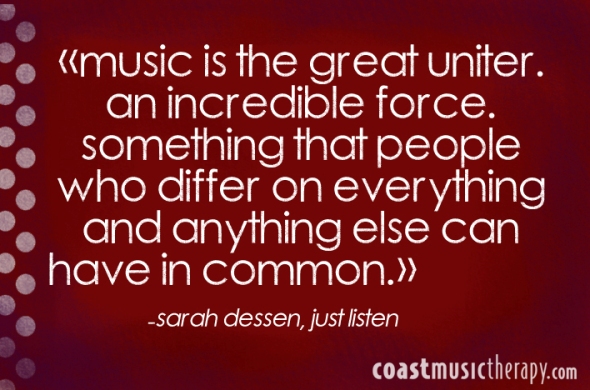
Music Therapy for Inclusion Settings
Posted October 29th, 2012 by Coast Music Therapy
Music can bridge the gap between children with and without disabilities.
Music is universal, spanning all cultures, ages, and abilities. We’ve seen incredible things happen with music therapy for inclusion settings when music is used to facilitate social interaction and understanding between students at differing ability levels.
Sarah Dessen’s words ring true in our daily music therapy work in special education:
“Music is the great uniter, an incredible force, something that people who differ on everything and anything else can have in common.”
Everyone can enjoy music on some level, whether it be through listening, watching a performance, or feeling the rhythm of a drum. Finding a shared interest is of incredible importance when facilitating friendships between children with special needs and typically developing children.
Music can also be a powerful non-verbal medium which can be a communication bridge for verbal and nonverbal students. The simple act of group dance, beating together on a drum, or listening to the same tune on an iPod can level the playing field for kids and teens who struggle to relate to more verbal peers.
Here are some simple music therapy activities to help facilitate inclusion and peer interaction:
Drum Inclusion Activity
Use a gathering drum to facilitate eye contact and social referencing by seating children across from each other around the drum. Try having them play along with a freeze game in which the teacher plays a song and then signals students to stop. For younger children, consider having them use their hands instead of mallets to avoid injury! End the drum activity by having everyone “rumble” with their hands quietly on the drum, than more loudly and quickly until the teacher signals “And……. STOP!” Demonstrate raising your hands in the air upon “STOP” and quickly remove the drum to prevent further playing.
Preschool and Elementary Partner Inclusion Activities
Divide students into partners, having them sit directly across from their partner in chairs or on the floor. Do not place a table in between the students unless this is needed as an initial assist for students who struggle with maintaining appropriate personal space. Ideally, pair a typically developing student with a student who has special needs. Choose from this variety of interactive songs for students to participate in with their partners.
1. Row Your Boat
Partners hold hands and row back and forth
2. If You’re Happy and You Know it
Start with typical lyrics “If you’re happy and you know it clap your hands” having students clap hands pat-a-cake style. Then create new interactive lyrics such as “Give a high five”, “Shake hands”, “Wave hello”.
3. You Are My Sunshine
Teach children movements that encourage eye contact and interaction:
You are my sunshine (point to each other)
My only sunshine (hand on chest signifying ‘my’)
You make me happy (smile at each other)
When skies are gray (frown at each other)
You’ll never know dear (point to head as if thinking)
How much I love you (each child crosses arms over own chest)
Please don’t take my sunshine away (shake head no)
Click here to download our free full color printable filled with ten more music activities you can try with preschool and early elementary-aged children .
What have been your experiences with music as a tool to cross the barrier between ability and disability?
Add a Comment
You must be logged in to post a comment.














